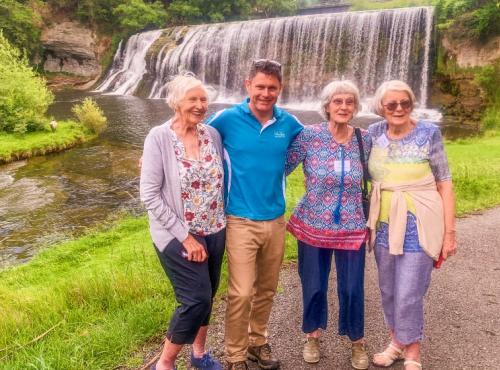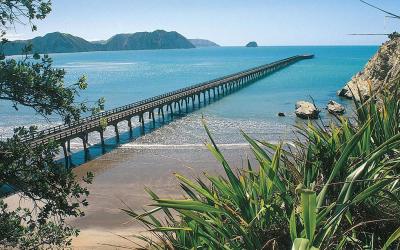
Kiwi Guide Stories - Travelling the East Cape
MoaTours Kiwi Guide Andrew led a happy group of travellers around the East Cape of the North Island, here’s the story of their adventure.
There are a couple of corners of New Zealand which really fit the description of being “off the beaten track”, places where you feel the world slow down and it's like you’re stepping back in time.
Luckily for us in New Zealand many of these places are also rich with stories of our history and culture and being blessed with natural scenery. The East Cape of the North Island is one of those for sure and has been a hit with our MoaTours travellers since 2005.
Day 1 - Auckland - Whakatāne
We Aucklanders love our city but we all know the value of getting out of town too. There's a great sense of freedom heading south on the motorway, over the Bombay Hills, and down into the Waikato countryside.
Even before lunch we were travelling through some sites of real historical significance which relate to the East Cape. The New Zealand Wars of 1863 started with British troops crossing the Mangatawhiri Stream and this is exactly where we were this morning.
I had been reading up on our “civil war” of the 1860s and sharing some stories and a few travellers approached me at our morning tea stop in Waihi to tell me they too have been reading and were very keen to learn more about it as we travelled around the Cape. No pressure then!
Our lunch stop was perfect to put us in holiday mode, right on the beachfront at Mt Maunganui. It was a beautiful day with a pleasant sea breeze and, after being treated to a wonderful lunch at our favourite waterfront cafe The Deckchair, right at the foot of the Mount, we all enjoyed a stroll along the beach.
After lunch we headed into the heart of the Bay of Plenty and Te Puke, the Kiwifruit Capital of the world and we happen to know the perfect place for an introduction.
Our friends Gavin and Amanda have been hosting MoaTours guests at a working orchard for many years and what Gavin doesn’t know about Kiwifruit isn’t worth knowing. You’ll learn how the fruit are grown and a bit of fascinating science behind it on a short guided tour around the orchard and, of course, we couldn’t leave without the chance to taste the bounty. It’s funny how learning all about Kiwifruit and seeing how they’re grown makes them taste even better.
After saying goodbye to Gavin and Amanda we continued through the Bay of Plenty countryside and along the coastline to Whakatāne for the night. Capping off a perfect first day, we were warmly greeted and enjoyed a delicious dinner at Roquette Restaurant, where we have been looked after for over a decade.
Day 2 - Whakatāne - Ōpōtiki - Hicks Bay
Leaving Whakatāne we took the high road for the short, but very scenic drive to Ohope Beach, the perfect little beach town and a great reminder of the beauty of the Bay of Plenty coastline. From here we winded our way through to Ōpōtiki, the true gateway to East Cape.
Ōpōtiki was the site of a very significant event in the New Zealand Wars in 1865 which ignited the East Coast wars through until 1872.
So I set everyone a little task, to find out what happened and report back. With a few New Zealand history buffs and retired school teachers on board the challenge was accepted and we had a lively discussion as we started out on the East Cape proper.
From Ōpōtiki onwards you really feel like you’re in a different world, a world that’s a lot slower than the city. If there’s one place which captures that in a single image it’s the Anglican Church right by the sea at Raukokore. It was such beautiful weather as we pulled up and enjoyed exploring the grounds with no one else around.
We continued around the coast to Te Kaha, a place that many Kiwis may not know much about but it was actually a busy whaling centre until the 1920s.
Our destination tonight was Hicks Bay, if you look on a map it’s really out there, right on the far tip of the East Cape so we were in a remote corner of the country now. We were welcomed by the locals and enjoyed a home style dinner with amazing views from the hilltops at our accommodation.
Day 3 - Hicks Bay - Anaura Bay - Tolaga Bay - Gisborne
We started our day with a quick trip over the hill to Te Araroa, home of the world’s largest Pohutukawa tree then we continued further round the coast to the little town of Tikitiki.
The great Maori leader Sir Āpirana Ngata (Ngāti Porou) was from this area and after World War I he wanted to build a memorial to the local Māori soldiers who made the ultimate sacrifice and St Mary’s Church is it. He also wanted to revive the traditional arts of weaving and carving and the interior of the church, completed in 1924, is both a living memorial and a showcase for Māori Arts.
We were greeted and given a warm welcome by the Canon of the church and his wife, it was both humbling and moving as he showed the memorial board with all the names of the fallen soldiers and a memorial to Sir Āpirana Ngata himself.
Our journey “off the beaten” track continued on to Anaura Bay where we visited our friend Judy Newell for lunch at her garden home, Rangimarie and enjoyed the stunning views out over the Bay.
Anaura Bay is another site of great historical significance, one of the earliest encounters between Captain Cook and Maori in 1769 was right here. Captain Cook’s diary tells of the early encounter and their forays on shore to get water and wood.
The online diaries of our early explorers give an amazing insight into these journeys and they’re all freely available and I’d encourage anyone with an interest in our early history to read them. It certainly brings a journey to the East Cape to life when you’re standing on the spot with the words written by the very people that were there.
After our wonderful lunch at Judy’s we continued on to Gisborne, on the way, of course, stopping in at Tolaga Bay for a walk out on the iconic wharf.
Day 4 Gisborne - Rere Falls - Eastwoodhill Arboretum - Gisborne
Today we explored the countryside around Gisborne. First stop was the picturesque Rere Falls about half an hour inland from the city. This area, Ngatapa, was also the site of a major engagement in the East Coast Wars between the rebel leader Te Kooti and the pursuing British troops.
Our highlight of the day without a doubt, was Eastwoodhill Arboretum and the story behind it is fascinating. This is the National Arboretum of New Zealand, a truly impressive collection of 4,000 different trees from all over the world.
Eastwoodhill was the life’s work of Douglas Cook, a larger than life Gisborne character who was inspired to create one of the largest collections of trees in the world after convalescing in the English countryside from wounds he suffered in World War 1.
We were driven all over the property in their open topped 4WD by the curator, Martin and, on the way, he shared his expert knowledge as well as colourful stories about “Cookie”, such as how unannounced guests would be surprised by his habit of working in the garden wearing nothing but one single gumboot!
Now it wouldn’t be a visit to Gisborne without trying some famous local wines so after saying goodbye to Martin and the tranquil green world of Eastwoodhill, we headed back towards town to treat ourselves to lunch and wine tasting at our favourite Gisborne winery, then on to the excellent Tairawhiti Museum while others took the option of a walk through town.
I have to give mention here to the wonderful dinners and super friendly service we enjoyed at The Works and USSCo (Union Steam Ship Company) restaurants. And our breakfasts at the Flagship Cafe were works of art (no joke, see the photo below).
Day 5 - Gisborne - Tiromoana Garden - Waioeka Gorge - Rotorua
We started the day with a visit to another significant site in New Zealand history, the lookout on Kaiti Hill overlooking the place where Captain Cook first landed here in Aotearoa on 9 October 1769.
We took in the scenery and I took a moment to read a few passages from Cook’s diary. This auspicious first encounter between European and Māori is controversial but a real part of our nation's story.
To compliment our coastal journey to Gisborne, our return trip was inland through the Waioeka Gorge. The forest clad hills and winding river views were a striking contrast to the landscapes of the coast for our journey back through Ōpōtiki and on to Rotorua.
This is also the route taken by Māori parties in the 1830s, dragging their waka through the bush for miles to meet up with the next stream, we pass right by one of the most famous of these sites at Hongi's track.
Rotorua felt like the big smoke after the tiny settlements of the East Cape, but we all enjoyed the comforts of our Lakeside Hotel, including the inhouse natural hot pools.
Day 6 - Explore Rotorua - Lake Tarawera - Auckland
Our last morning was spent exploring Rotorua and the surrounding lakes area.
First we visited geothermal Kuirau Park, there can’t be many cities in the world which have bubbling mud and steaming vents in a public park. Then we met our guide for a tour of the Rotorua Museum gardens.
We then headed out to Lake Tarawera for lunch with the locals - Karen, her husband David Walmsley, and their daughter Tracy are like family now. They trace their Tarawera guiding heritage back to Guide Sophia, one of the most famous Rotorua guides of all.
Guide Sophia was immortalised in a Gottfried Lindauer painting and foresaw the Mt Tarawera eruption in 1886 with a vision of a “ghost waka” on the lake. Over the years meeting Karen and Tracy we know what people remember more than anything is the warmth of their welcome.
Karen and Tracy also guided us on our visit to Te Wairoa Buried Village and Museum. We were sad to say goodbye and reluctantly started the journey back north.
For all of us, this was a wonderful week in a part of the country none of us had spent much time in before. The combination of the scenery, Māori and European history and the friendly people we met along the way made it the perfect escape with a real feeling of getting to know our own country a little better than before.
I hope you enjoyed this recollection of our trip, of course nothing beats visiting first hand. Our East Cape Caper trip has been a favourite for over 15 years and we’ll be off again this coming season. We’d love you to join us!
If you’d like to see more pictures from the trip you can see more about our East Cape Caper 6 day tour here.




















